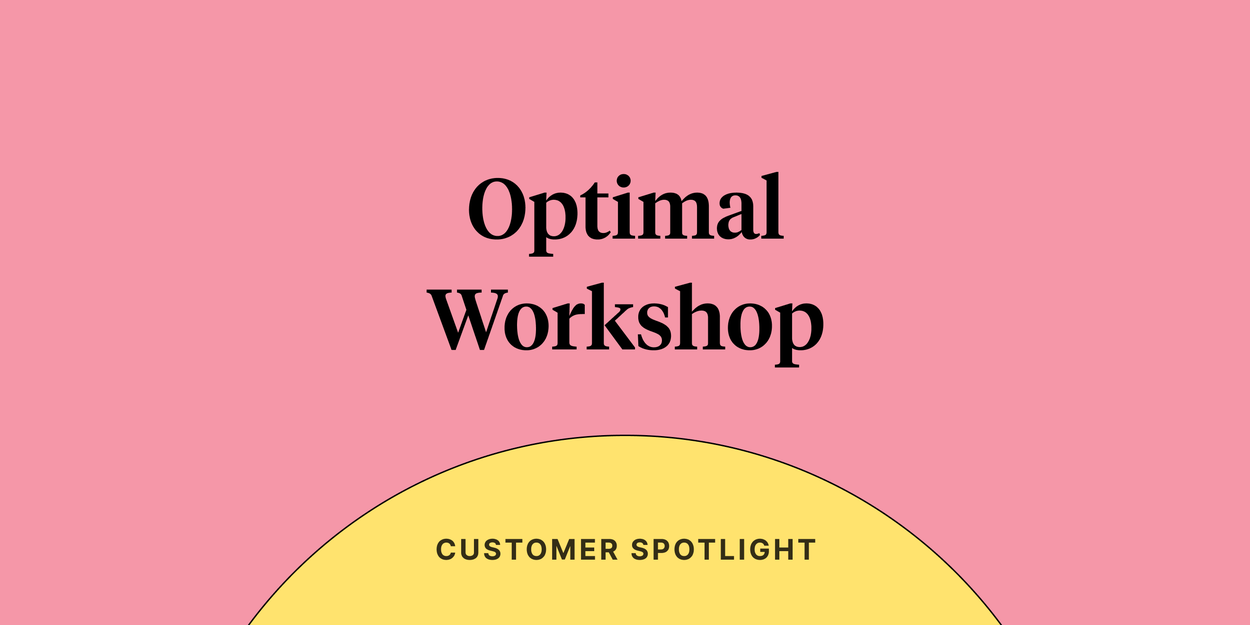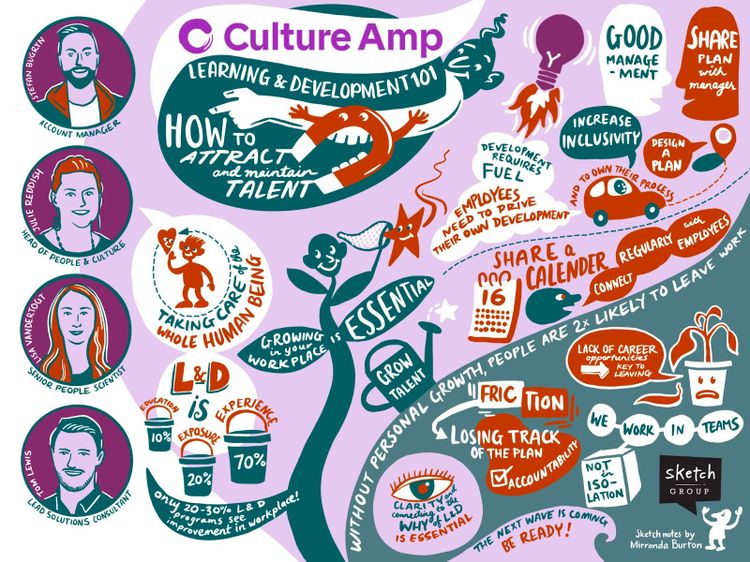
Learning & development 101: How to attract and retain talent

Employees are eager to learn and develop. How you encourage and support their ability to do so plays a huge role in their experience and your overall success as an organization.
Yet, when resources are tight and schedules are busy, employee development is often one of the first things on the chopping block.
In the third session of our “Back to Basics” webinar series, Lisa Vandertogt, Senior People Scientist here at Culture Amp, and Julie Reddish, Head of People and Culture at user experience research platform Optimal Workshop, discussed why employee development is crucial – especially in times of uncertainty – as well as how organizations can make the most of their learning programs, regardless of their budgets.
Why is employee development important?
When it comes to the importance of employee development, retention is often one of the first talking points – and for good reason. How you support employees as they grow and learn has a powerful impact on their willingness to stick with your company.
According to Culture Amp data, lack of career opportunities is the most-cited reason employees give for leaving in their exit surveys. It carries more importance than compensation, work-life balance, and their direct manager combined.
But learning and development opportunities don’t just retain current employees – they also attract new ones. In fact, Julie says that the number one question Optimal Workshop gets asked in interviews is about their approach to learning and development and how much they spend per person.
Fortunately, they have a solid answer. “We really do care that the whole human being is cared for,” Julie explains. “People care about having a place where they can grow as a human being, so we prioritize it.”
In short, growth and development isn’t a luxury – it’s a key piece of your organizational strategy. Getting it right helps you attract top talent, combat turnover, upskill your workforce, boost engagement, and enhance performance.
How to supercharge your approach to learning and development

“Getting it right” is the hard part, though. Too often, organizations default to throwing an assortment of learning opportunities in front of employees in hopes they’ll self-select what they want. But that’s not only ineffective – it’s overwhelming.
“If you have a bunch of learning programs on offer but no connection or ability to link that to what an employee is trying to achieve or learn, development quickly becomes a ‘tick the box’ experience for employees,” says Lisa. “It’s no longer a benefit or perk – it’s more just another thing that they have to do.”
Here are a few tips organizations can use to offer development opportunities that go beyond a buffet of random resources and actually offer personalized support as employees expand their knowledge and skill sets.
1. Keep it simple and visible
One of the first things companies need to do is to understand the friction in employee development. What stops people from taking action?
Below are a few common obstacles, along with tips for addressing them:
- Not knowing where to start: Employees feel overwhelmed with the options available and avoid them altogether. “Having a really clear process that supports and guides employees to develop their plan is great fuel to overcome this friction point,” Julie says.
- Losing track of the plan: You might create a development plan with the best intentions during your review cycle, but it gets filed away and is readily forgotten. This can be overcome by sharing development plans with managers and setting frequent and clear review cadences.
- Lacking accountability: For many employees, development can feel like something they do on the side – it’s a task they’ll get to if they ever have the time. Julie says that’s why it’s important for employees to have someone who is advocating for them and their development plans in the first place. Ensure your employees treat their development as a priority, build it into their schedule, and have a skilled person to turn to if they have questions.
This guidance may not resolve all of your challenges, but it will certainly knock down some initial development barriers for your employees and your entire organization.
2. Move beyond traditional learning programs
The truth about traditional learning programs is that they rarely lead to sustained behavior change. “If we are exposed to content as a one-off without specific contextualization in our work, it is likely to have very little impact on the day-to-day,” Lisa says.
By some estimates, only 10-30% of training translates to changes in the workplace, so it’s time to think more strategically about your development action plan. Its success hinges on understanding and embedding the three E’s:
- Education: Absorbing fundamental concepts and ideas through structured learning, like courses, online resources, books, podcasts, and more. This should demand only about 10% of your focus and attention when action planning employee development.
- Exposure: Learning through observation, such as job shadowing, building cross-functional connections, networking, and participating in professional associations. This should demand about 20% of your focus and attention.
- Experience: Real, on-the-job experience through efforts like stretch projects with plenty of reflection and coaching. This is the meatiest piece, requiring about 70% of your focus and attention.
This approach takes organizations and employees beyond only the education component, which can also be the most costly piece of development, while also emphasizing connection – a point Optimal Workshop feels strongly about.
When employees participate in a course, attend a conference, or engage in any other learning activity, they’re encouraged to share it with others – whether that’s a short recap during a team-wide meeting or in a dedicated Slack channel. “It bonds people closer together as well as helping somebody really cement their own learning,” Julie explains.
3. Create intentional learning space
The workday gets busy, and development is quickly written off as an extravagance that can easily slip onto the back burner or fall off the stove entirely. That’s especially true when priorities, budgets, and even entire industries are uncertain.
“I think [development] is one of those places you can actually bring certainty in uncertainty,” Julie shares.
At Optimal Workshop, they’ve all agreed to respect each other’s focus time. And, they also expect leaders to carve out their own time for learning and development. This type of role modeling shows employees that they can and should follow suit. As Lisa says, it “puts it on the agenda without even putting it on the agenda.”
4. Empower employees to drive their own development
Who’s in the driver’s seat of an employee's development? It’s not their manager – it’s the employee themselves. “The person is responsible for driving their own learning forward,” Julie explains about Optimal Workshop’s overall ethos of self-management. “No one can make you learn.”
But that doesn’t mean employees need to move forward completely alone. There are plenty of other supporting players throughout the organization. At Culture Amp, here’s how we think about responsibilities in employee development:
Company:
- Provide the structure, systems, processes, and resources
- Set the tone culturally
Leaders:
- Coach and support team members to grow and develop
- Remove barriers preventing development
- Connect employees to opportunities
- Help team members build a plan and take action
Team members:
- Take ownership of plan and be accountable for driving their own development
- Set goals and track actions
Julie explains that the senior leadership team also plays a key role in sharing the gaps so coaches and managers can steer employee development toward those areas. After all, professional development is most impactful when it aligns with the organization’s overarching needs and objectives.
5. Actively involve managers
“From our research, we know that when an employee feels that their manager shows an interest in their career aspirations, they’re more likely to be engaged,” Lisa says.
Encourage managers to adopt a coaching mentality and serve as the employee’s most prominent advocates as they learn and develop. This doesn’t need to be a complex undertaking – a lot of it can happen during seemingly humble one-on-one meeting, particularly if there’s plenty of clarity ahead of time about what will be covered and how employees can prepare.
At the same time, commit to providing managers with plenty of learning opportunities of their own, particularly when it comes to knowing how to support employee growth. It’s unrealistic to expect managers to know how to handle every single situation, so equipping them with plenty of support, guidance, and resources helps them develop – and then use that newfound knowledge to support employees.
Employee development: An essential, not an extravagance
Employee development is often viewed as a tertiary pursuit or even a distraction. But the reality is that it’s a significant factor in your ability to retain talent, attract new employees, and fuel both employee engagement and performance.
Needless to say, it’s not something that organizations can afford to write off as a frivolous extra. It’s time to view development as the strategic endeavor it is – and then prioritize it accordingly.





